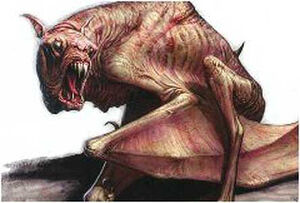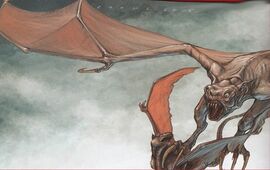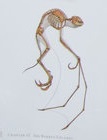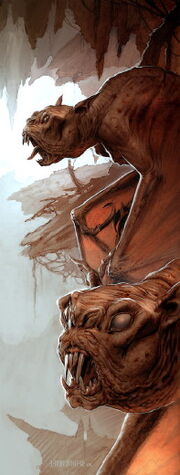
The Terapusmordax, Terapusmordax obscenus, is a large, vicious volucerictid from the uplands of Skull Island. It has a body-length of 3-4 feet and a wingspan of 8-10 feet.
Lord of the skies over Skull Island is no bird of prey or pterodactyl pterosaur, but a naked-skinned, bat-winged rodent with a stench to make noses bleed. The Terapusmordax, in appearance a hideous mix of bat and naked mole rat, is in fact a species of flying rodent. It is the largest of the volucerictids, a family of winged rodents peculiar to Skull Island. A handful of the related species exist everywhere else on the island, including Volucerictis and the howlers, but all are dwarfed by this monster.

Terapusmordax have thin, almost transparent skin and light but strong bones. They have good eyesight and are excellent flyers. Despite their size, they are quite maneuverable, able to tip and roll in the air in pursuit of one another or winged prey.
Terapusmordax make their homes in vast caverns in the uplands, hanging bat-like from the cave ceilings by their feet at night. The cave floors are littered with the feces of their colonies, which can number in the hundreds. Their waste contains pungent chemicals that, in sufficient quantity, induce watering eyes and burning nostrils in other species. The reek of this accumulated waste is so overpowering that it drives would-be larger predators away from the colony, guaranteeing the safety of the young and infirm. Excrement often cakes the bellies of these of the creatures, but they appear unaffected. Indeed, this be a defense in and of itself. Even when on the ground, far from the colony, a Terapusmordax is unlikely to be bothered by flightless carnivores due to the nauseating stench.


Colonies are matriarchies, ruled by pugnacious females awash with male hormones to increase their size and strength. These brutish females roost, forage, and share the raising of young together. The solitary males nest in small satellite bachelor colonies of a dozen or so individuals for mutual protection at night. Not being social, they bicker constantly. Among males, infection due to nips and scratches is common. They are kept at a distance from the female colony due to their propensity to kill pups in order to bring their mothers back into season. Males are driven out of the nest while still young. The solitary male pups pick each other off, to avoid potential rivals later in life. The unprotected male pups also fall prey to other predators. Consequently, adult females outnumber males, due to the extra protection living as a group affording female pups.
Terapusmordax are omnivorous, eating fruit (such as nuts) from the jungle and plucking lizards and small non-avian dinosaurs from the ground when they can get them. They often catch food on the wing, chasing birds and other fellow flying creatures. Common prey are vultursaurs and Volucerictis, which they catch at dusk.

No survivors[]
One creature alone makes a living in the rank pestilence below Terapusmordax colonies: the Megapede impurus. M. impurus crawls in the filth beneath the colony, waiting for the inevitable fall of careless young. Terapusmordax give birth to litters of 4-6 pups and attrition does occur. A single fall can result in disabling injury. If the venomous centipedes find the wayward pup before it can crawl back, it is doomed.
Relationship with Skin-Birds[]
Skin-birds are among the few species that seem unperturbed by the noxious dung smell of Terapusmordax colonies. Brave individuals will penetrate a colony to prey on their pups, but they will have to be quick to get in and out before being set upon by the adults of the bigger volucerictids. Terapusmordax will drive skin-birds away from their colonies when they spot them.
When visiting the Chasms[]
Winged predators like Terapusmordax use the twisting chasms to herd and harass smaller flying animals into dead ends, where they trap and catch them.
